
* Given the widespread use of the F-16, it is not surprising that it has led to a number of international derivatives, indirectly or directly based on the F-16 design. All these machines were developed in the Far East, and include the Taiwanese "Ching Kuo Indigenous Fighter", the Japanese "Mitsubishi F-2", and the South Korean "Golden Eagle". This chapter provides a description of these aircraft.
* The Taiwanese Aero Industry Development Center's (AIDC) "Ching Kuo" is essentially a new aircraft that clearly differs from the F-16, but equally clearly owes much to the F-16 design. In the mid-1970s, America's firm support of Taiwan began to waver as the US worked on a rapprochement with mainland China, and Taiwan also began to realize that mainland Chinese pressure to discourage nations from exporting weapons to Taiwan was proving effective. The mainland Chinese were introducing improved aircraft, most notably the J-7 copy of the Soviet MiG-21, and Taiwan needed new, superior fighters to meet the threat.
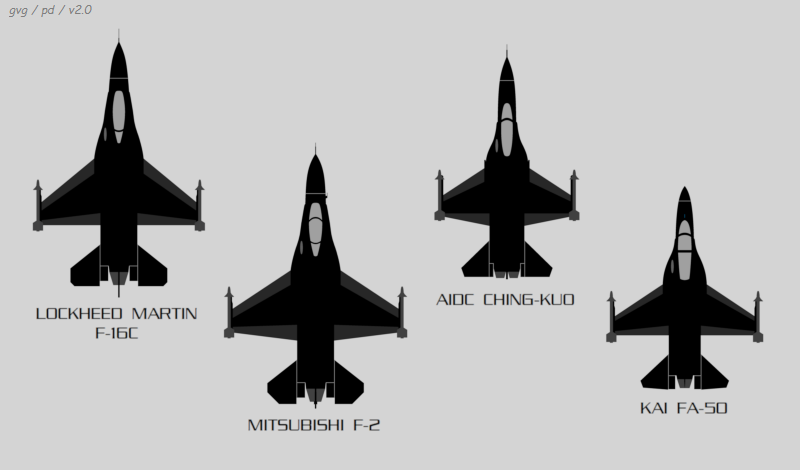
Taiwan's existing fighter assets included the Lockheed F-104 Starfighter and the Northrop F-5. The Taiwanese were particularly fond of the F-5, since it was effective, easy to fly and maintain, and inexpensive to buy and operate. They were interested in obtaining Northrop's much-improved F-20 Tigershark derivative, but the US government blocked the sale, as well as purchase of the F-20's rival, the General Dynamics F-16. The Taiwanese government decided that the only available option was to build their own fighter.
This decision was influenced by the fact that the US imposed very few restrictions on technical support to Taiwan, as well as the island nation's interest in improving its industrial technology base and increasing exports. Preliminary design studies for a Taiwanese "Indigenous Defense Fighter (IDF)" began in 1980, followed by a formal program launch in 1982.
The design was formalized in 1985, with major assistance from a team of General Dynamics engineers working under a $50 million USD contract. AIDC also received assistance from other US aerospace firms, including Menasco, Garrett, Westinghouse, Bendix/King, and Lear Astronics. Four prototypes were built, including three single-seat machines and one tandem-seat machine. The first prototype performed its initial flight on 28 May 1989. This machine suffered an embarrassing landing accident on 29 October 1989, when its front landing gear collapsed in front of Taiwanese President Lee Tung Hui and the press. The damage was not critical and was quickly repaired.
The type received the formal name of "Ching Kuo" in honor of former Taiwanese president Chiang Ching Kuo, son of Chiang Kai-shek. The tandem-seat version was intended for operational conversion and proficiency training, but was combat-capable.
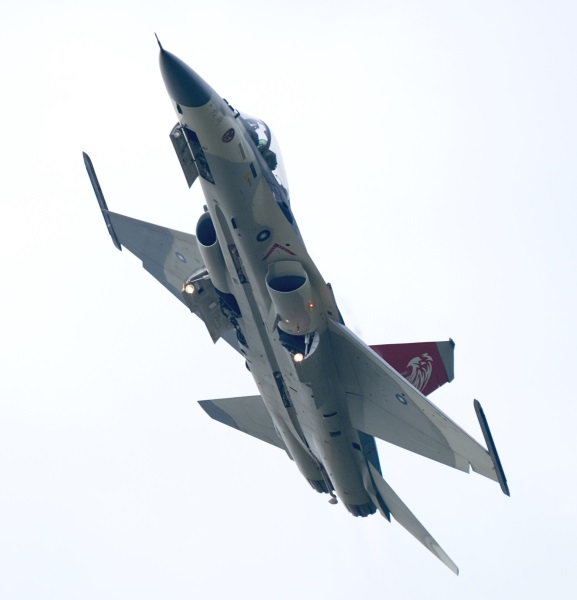
* From the side, the Ching Kuo had a certain general resemblance to the Northrop F-5, with some flavor of the F-5's descendant, the F/A-18 Hornet. From the top, the resemblance to the F-16 was obvious, and it could be easily mistaken for an F-16 from such an angle. The arrangement of flight surfaces was very similar, with a wedge-style wing featuring LERXes and some wing-body blending, a single tailfin, and all-moving tailplanes.
The most visible difference was that the Ching Kuo had two engines instead of one. It was powered by twin Garrett TFE1042-70 bypass jets, with dry thrust of 27.0 kN (2,748 kgp / 6,060 lbf) and afterburning thrust of 42.3 kN (4,308 kgp / 9,500 lbf) each, and with the elliptical intakes under the wing roots. The TFE1042 was an afterburning derivative of the popular TFE731 turbofan, used on a variety of business jets and jet trainers. It suspected that this engine was partly selected on the basis that its procurement wouldn't raise a "red flag" to the mainland Chinese. The engines were actually built by a Taiwan-based partnership between Garrett and AIDC, the "International Turbine Engine Company (ITEC)".
Garrett also supplied an interesting combined "auxiliary power unit / emergency power unit (APU/EPU)" for the Ching Kuo. The APU took a little time to come up to speed, and so if there was a complete power failure, the quick-start EPU fired up to sustain power until the APU came up to speed.
Even with two engines, the total thrust was only about two-thirds that of the F-16's P&W F100 engine, but the Ching Kuo was smaller than the F-16, being more the scale of an F-5. In fact, the best way to think of the Ching Kuo was as a next-generation F-5, based on F-16 concepts. It was about 50% heavier than an F-5E, but with twice the thrust.
The Ching Kuo was of conventional construction, made mostly of aircraft aluminum alloys. Steel was used in some high-stress or high-temperature areas, while titanium was used for the jetpipes, and graphite-epoxy composite was introduced following initial production for fin and tailplane skins, access panels, and a few other items. The fighter featured a dual-redundant hydraulic system and dual-redundant fuel-supply system, with fuel tanks in the fuselage and wings. The fuel tanks were pressurized by inert Halon gas to reduce fire hazard.
The Ching Kuo had tricycle landing gear of clearly lighter construction than that of the F-16; the Taiwanese fighter was not intended to carry as heavy an offensive warload, so it could get by with the lighter landing gear. All three landing gear assemblies retracted forward, with the main gear wheels pivoting to lie flat in the fuselage.
___________________________________________________________________
AIDC CHING KUO (SINGLE-SEATER):
___________________________________________________________________
wingspan (over wintip AAM rails):
9.46 meters (31 feet)
wing area:
24.26 sq_meters (261.1 sq_feet)
length (with nose probe):
14.21 meters (46 feet 7 inches)
height:
4.65 meters (5 feet 3 inches)
empty weight:
6,486 kilograms (14,300 pounds)
normal take-off weight:
9,525 kilograms (21,000 pounds)
max take-off weight:
12,247 kilograms (27,000 pounds)
max speed at altitude ("clean" configuration):
1,275 KPH (792 MPH / 688 KT)
service ceiling:
16,760 meters (55,000 feet)
___________________________________________________________________
The Ching Kuo was armed with a single General Electric M61A1 Vulcan cannon, mounted as on the F-16 in the left wing root, with 515 rounds of ammunition. The fighter had nine stores attachments, including a centerline pylon; two missile recesses under the fuselage, which couldn't be used if the centerline pylon was fitted with a large store such as an external tank; two pylons under each wing; and an AAM launch rail on each wingtip. The centerline and inner wing pylons were "wet" and could carry external tanks -- either 1,041-liter (275 US gallon) tanks similar to those carried by the F-5E, or smaller 568-liter (150 US gallon) tanks.
The Ching Kuo's primary role was air combat, and it could carry the "Tien Chen 1 (Sky Sword 1)" AAM, a Sidewinder-class weapon, or the "Tien Chien 2" AAM, a Sparrow-class weapon. Surface attack was a secondary role, with a particular emphasis on antiship attack using the "Hsiung Feng (Brave Wind)" antiship missile -- a Harpoon-like weapon apparently developed with Israeli assistance. Other possible attack stores included the AGM-65 Maverick ASM, iron bombs, cluster munition canisters, and 70-millimeter (2.75-inch) unguided rocket pods. Maximum external warload was 4,080 kilograms (9,000 pounds).
The Ching Kuo's primary sensor system was the Golden Dragon 53 (GD-53) radar, derived from the General Electric AN/APG-67(V) radar, developed for the F-20 Tigershark, with some features of the Westinghouse AN/APG-66 of the F-16A. The Golden Dragon 53 had modes for air-to-air and air-to-surface combat, with look-down / shoot-down capability, and a range of 150 kilometers (93 miles). Other important avionics subsystems included a Lear-Siegler flight computer; a Honeywell inertial navigation system; and a radar homing and warning unit. The fighter had a digital fly-by-wire system, with an independent triple-redundant analog fly-by-wire system. Avionics were linked by twin redundant MIL-STD 1553B digital data buses.
The cockpit layout was similar to that of an F-16, featuring a Bendix-King wide-angle HUD; twin multifunction displays (MFDs); and a sidestick controller on the right with a throttle on the left, studded with HOTAS controls. The original MFDs were monochrome, but later production had color displays. The pilot sat on a Martin Baker Mark 12 zero-zero ejection seat. As with the F-16, the seat was canted back 30 degrees. The canopy was blasted off as a unit by rocket thrusters before ejection. The cockpit was designed for Taiwanese pilots and was something of a tight fit by Western standards.
The canopy for the single-seat Ching Kuo hinged up from the rear as a single unit. The canopy for the tandem-seat Ching Kuo hinged to the left side. The tandem-seat Ching Kuo was a minimal conversion of the single-seat variant, with no change in external dimensions and the second seat accommodated by removing a fuselage fuel tank. The rear seat was not raised, giving the back-seater a poor view forward.
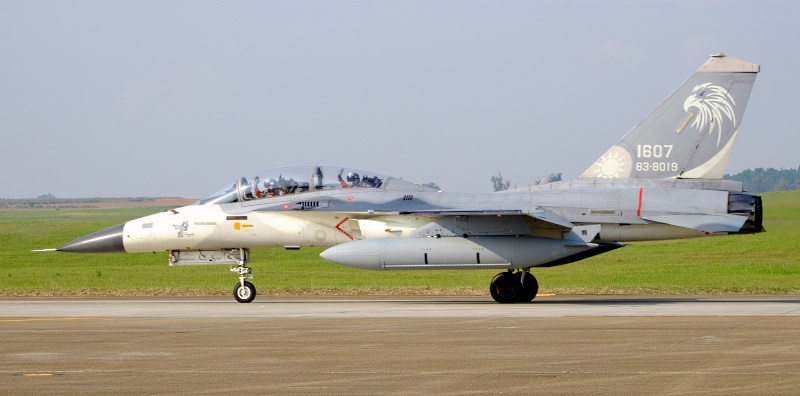
* Initial service deliveries of the Ching Kuo were in 1994, but by that time the obstacles against Taiwanese weapons imports had eased, and the nation was able to obtain modern fighters from other countries. As a result, production of the Ching Kuo was limited to 121 production machines, 106 of them "F-CK-1A" single-seaters, with 29 "F-CK-1B" two-seaters. Original plans had been to acquire 420 Ching Kuos, with the smaller production run unsurprisingly raised unit price sharply.
From 2001, the Ching Kuo fleet was updated to "F-CK-1C/D" standard, adding compatibility with new Taiwan-designed munitions, new avionics, and conformal fuel tanks. A follow-on upgrade program was announced in 2011, the primary features being improvements to the radar and color cockpit displays. The entire fleet was upgraded, in two phases, with the program completed in 2016. The upgrades increased the type's service life by 20 years.
From 2017 the Ching Kuos were upgraded to carry four AAMs instead of two, including the improved Tien Chien II AAM -- with range enhanced by over 50%, and presumably an updated seeker system. Some sources have judged the Ching Kuo limited and underpowered, others suggested that it was an excellent implementation of a true lightweight fighter, comparable to the Swedish SAAB 39 Gripen fighter, and that it could potentially have done well on the export market. Few could have faulted it for looks, though.
In 2019, AIDC unveiled the first of four prototype / evaluation "Yong Ying (Brave Eagle) Advanced Jet Trainer (AJT)" machines derived from the two-seat Ching Kuo. It had the same configuration, but lacked radar and cannon; it had a redesigned wing, and its airframe contained a high proportion of composite materials. It was powered by twin Honeywell / ITEC F124-200TW non-afterburning engines. First flight was in 2020, with delivery of the first of 66 "T-5" trainers, as the variant is designated in service, for the ROCAF in 2021.
BACK_TO_TOP* In contrast to the Ching Kuo, the Japanese Mitsubishi "F-2" fighter was clearly a true member of the F-16 family. It began in 1982 as an intent by the Japan Defense Agency (JDA) to obtain a replacement for the existing Mitsubishi F-1 fighter, which had been judged an interim type and was only built in limited numbers. The replacement was to be a much more capable aircraft, with a primary focus on antiship / strike roles, and a secondary focus on air combat. The effort crystallized under the designation of "Fighter Support X (FS-X)".
As it turned out, improved estimates of the useful service life of F-1 airframes showed that the type could be kept in service for longer than anticipated, and so pressure for a replacement declined. It did not evaporate, and the JDA considered either obtaining the FS-X from Japanese industry or buying it from a foreign manufacturer.
The JDA considered the General Dynamics F-16, the McDonnell Douglas F-18, and the Panavia Tornado as possible foreign FS-X solutions. In late 1985, the JDA sent a request to the three foreign manufacturers to see if their aircraft could fit Japanese needs. The request specified a fighter with a maximum warload of four Japanese ASM-1 antiship missiles and two to four short-range AAMs in the strike role, or two to four medium-range AAMs with some other mix of weapons in the air combat role. The aircraft was to have all-weather combat avionics and an operational radius of 834 kilometers (518 miles / 450 nautical miles) in the antiship strike role.
The three companies replied in early 1986. The JDA examined the responses and then replied that none of the foreign solutions met Japanese needs, and that a Japanese-built machine was the only solution.
* That's when the trouble started. The reaction of the foreign manufacturers was that they'd been had, they'd been handed a "lockout spec" that was designed from the start to exclude them and declare a Japanese-built machine as the winner. The US, German, and Italian governments registered strong complaints with the Japanese government.
The pressure from the US was intense. Americans were feeling very sore and touchy about Japanese economic power at the time, in particular objecting to what was seen as one-sided Japanese trade policies. Americans perceived a decision by the Japanese to develop their own first-line fighter as at the least a snub to American export aircraft, or at the most an attempt to acquire another domain where Japan could compete internationally with American products.
The second concern was overblown, since at the time the Japanese constitution blocked exports of weapons, and Japanese aerospace / defense programs have a notorious history of turning out mediocre products that cost multiples of the same or better item available from another country. However, the fact that the Japanese were willing to build their own fighter instead of buying a cheaper and arguably better American machine did lend weight to the Americans feeling short-changed.
In the spring of 1986, the JDA went through the exercise with the foreign manufacturers again, asking if they could provide variants of their machines that could meet the FS-X specification. All three came back with various proposals that summer. By this time, the favored solution was to co-develop an aircraft with the US. The Americans had the most political clout in Japan, and the long tradition of Japanese license production of US combat aircraft made a relationship with a US company preferable to one with a European manufacturer.
The JDA sent a team to the US to investigate possible FS-X solutions, including the F-16, F-15, and F-18. To make a long story short, the Tornado was quickly eliminated, and on 21 October 1987 the decision was announced to develop a modified version of the F-16C/D, based on the GD "Agile Falcon" concept with the big composite wing. The new aircraft was to be built by a collaboration between Japanese and American companies.
* On the surface, that seemed to be a good deal for both sides, since the US would obtain economic benefits from the arrangement while Japan would be able to reduce development time and cost by leveraging off existing technology. Unfortunately the barking across the Pacific only seemed to get louder, becoming a lunatic comedy. Americans accused the Japanese of trying to steal US expertise, while Japanese accused the Americans of dumping second-rate technology on them.
In the 1990s, as the F-2 program got underway, Japan ran into persistent economic difficulties, with the Americans gradually doing an about-face from outrage over Japanese trade policies to pressure on Japan to institute economic reforms and get the Japanese economy back on track. There were still tensions between the two nations -- unsurprising given their cultural differences -- but the overblown public quarrels faded into the background. The international controversy over the F-2 was forgotten.
That was one of the few problems with the whole program that seemed to resolve itself, since the supposed benefits of leveraging off an existing aircraft design didn't work out. In fact, the F-2 program turned into a classic Japanese defense-aerospace program, with development problems, long delays, and cost escalation. The F-2 that emerged costs three to four times as much as its F-16 parent.
The traditional difficulties of the Japanese in developing advanced weapon systems are a bit puzzling, given the fact that the Japanese are well-known for sophisticated, first-class, low-cost consumer and industrial products. Japanese ambivalence towards weapons systems plays a role, while the Japanese government also suffers from a traditional addiction to "pork barrel" projects -- and in the case of the F-2, the politically-driven US-Japan manufacturing arrangement did nothing to encourage efficiency.
* In any case, the first F-2 prototype performed its first flight on 7 July 1995. Four prototypes were built, including two "XF-2A" single-seaters and two "XF-2B" tandem-seaters. Late in that year, the Japanese government authorized the production of a 83 F-2As and 47 F-2Bs for a total of 130 aircraft. First deliveries were to be in 1999, but due to various difficulties the date slipped out to 2001.
The general configuration of the F-2 was all but identical to that of the F-16, and it takes a trained eye to distinguish the two aircraft. The F-2 did have clear differences, in that its wing had 25% greater area than that of the F-16 and a span increased by 1.68 meters (5 feet 6 inches); a tailplane assembly that was about 20% larger than that of an F-16; and a slight fuselage stretch to accommodate increased fuel capacity and new avionics.
The nose contours were also subtly different, giving the F-2 a more "duckbilled" appearance relative to the F-16. The F-2 was supposed to have twin fins under the engine intake, apparently something like the fins on the AFTI F-16, but these fins were deleted in the final design definition. The F-2 also had a brake chute, and the long brake chute fairing at the base of the tail was another distinctive identifying item.
Some of the changes were less visible. The wing was of all-composite construction, with leading edges incorporating radar-absorbent material (RAM), and the F-2 was one of the first operational aircraft to be fitted with an AESA radar, the "J/APG-1". The radar was built by Mitsubishi and had modes for air-to-air and air-to-surface combat, as well as navigation.
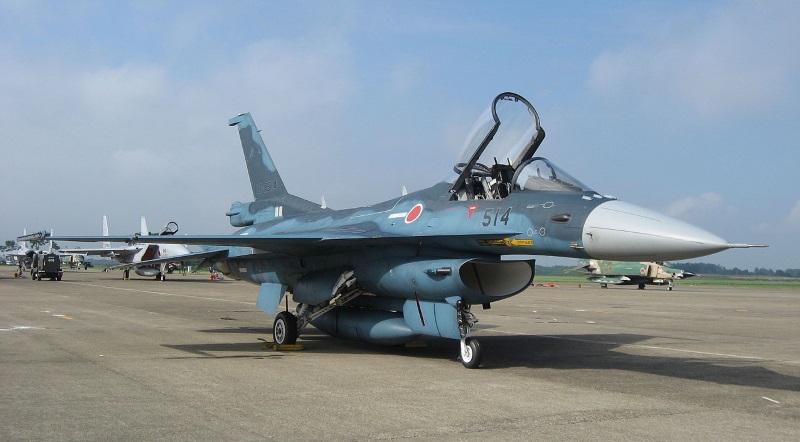
The F-2 did retain the F-16's engine, being powered by an F110-GE-129 bypass jet with 75.6 kN (7,710 kgp / 17,000 lbf) dry thrust and 131 kN (13,380 kgp / 29,500 lbf) afterburning thrust. Like the F-16, the F-2 also featured a built-in 20-millimeter Vulcan cannon in the left wing root -- though it was a JM61A1 built in Japan under license, and not built by GE. Ammunition capacity was 512 rounds.
The F-2's big wing allowed it to carry a greater external warload of up to 8,085 kilograms (17,824 pounds). The F-2 was typically fitted with three stores pylons under each wing, along with launch rail on each wingtip for an AAM and a centerline pylon, but could also be fitted with an additional pylon just inboard of each wingtip, for a total of 11 stores attachments. The centerline pylon was wet and could be used to carry a 1,136-liter (300 US gallon) tank, while the inner pylon on each wing was wet and could be used to carry a 2,271 liter (600 US gallon) tank. There was no provision for inflight refueling; the Japanese traditionally did not like inflight refueling, since it might imply an offensive posture -- though in recent years they have become more assertive, and have acquired Boeing 767 tanker aircraft.
___________________________________________________________________
MITSUBISHI F-2A:
___________________________________________________________________
wingspan (over wingtip AAM rails):
10.8 meters (35 feet 5 inches)
wing area:
34.84 sq_meters (375 sq_feet)
length:
15.52 meters (50 feet 11 inches)
height:
4.69 meters (14 feet 5 inches)
empty weight:
9,527 kilograms (21,003 pounds)
combat take-off weight:
20,517 kilograms (45,231 pounds)
MTO weight:
22,100 kilograms (48,721 pounds)
max speed at altitude:
2,125 KPH (1,320 MPH / 1,145 KT)
combat radius:
835 kilometers (520 MI / 835 NMI)
___________________________________________________________________
Typical stores for air combat included the AIM-7F/M Sparrow and AIM-9L Sidewinder AAMs, both built under license in Japan, and the Japanese AAM-3, essentially an improved Sidewinder. Air-to-surface stores included heat-seeking bombs, which the Japanese have developed as an antiship weapon, and the solid-fuel ASM-1 antiship missile and its jet-powered successor, the ASM-2. Incidentally, the Japanese described these as "anti-landing craft missiles" to emphasize their defensive posture -- though that hardly means they couldn't be used on other naval targets.
The cockpit featured a holographic head-up display, three Yokogawa multifunction displays, and typical F-16 HOTAS / sidestick controller layout. The pilot sat on a US-built ACES II ejection seat, and the canopy was strengthened relative to the F-16's. Oxygen was provided by an on-board oxygen generating system (OBOGS).
The F-2 featured a triple redundant digital FBW control system with a one-level analog backup, developed by Japan Aviation Electronics and Bendix/King. A navigation suite was included, with an inertial navigation system, TACAN, radar altimeter, and other kit, though it didn't seem to include a GPS receiver. The pilot could track his location though moving-map displays. The fighter featured a sophisticated countermeasures suite that was mostly classified, but included both passive warning systems and active defenses, including jammers and chaff-flare dispensers.
The two-seat F-2B was intended for operational conversion and proficiency training, but was fully combat capable. The back seat layout was similar to the front seat layout, though it lacked a HUD and some auxiliary controls. Fuel capacity was cut by 685 liters (181 US gallons) to accommodate the second seat.
* When the F-2 was introduced to service, the plan was to acquire 130 aircraft. Unfortunately, the F-2's history simply could not be overcome: by the summer of 2004, the JDA had realized the type was about as expensive as a McDonnell Douglas F-15J heavy fighter -- but not as capable, and with less growth potential. At the time, 76 F-2s had been delivered or were on order. The JDA decided that one more batch of 10 or 20 machines would be purchased, and that would be the end of production. This left only the F-15J and the McDonnell Douglas F-4J Phantom in service with the JASDF as first-line fighter aircraft. The F-15J will definitely be retained, but the F-4 urgently needs to be replaced.
In truth, the F-2 seems to have been one of the excesses of Japan's boom years, when the sky seemed the limit. However emotional and overwrought the Americans had been over the issue, they were strongly vindicated in the end; but it was Japanese taxpayers who really ended up being cheated on the deal. If the goal had been to improve the competitiveness of Japan's industries, it would have been more rational to have focused on much less ambitious programs in commercial aviation.
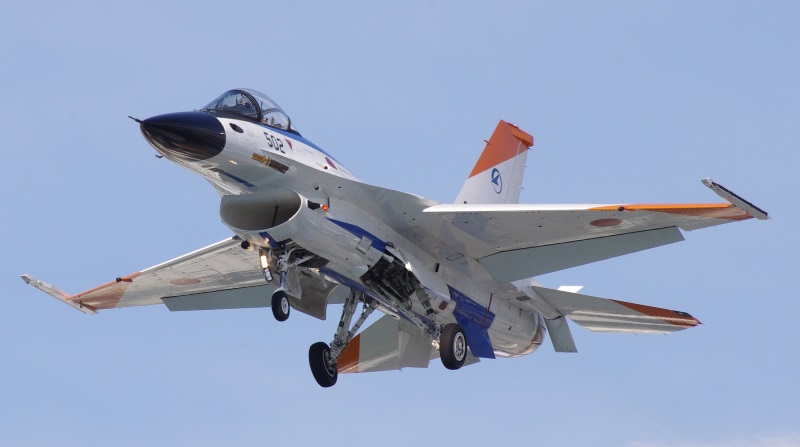
Whatever the difficulties with the F-2 program, the aircraft remains in service, with an upgrade having been performed. The primary driver was carriage of the advanced "AAM-4B" missile, a Sparrow follow-on roughly comparable to AMRAAM; there never was a production "AAM-4A", by the way. The F-2 radar was upgraded to the "J/APG-2" standard to support the missile, with a "J/ARG-1" datalink transmitter also being added to provide midcourse guidance updates to the AAM-4B. The "AAM-5", a follow-on to the AAM-3, was also qualified. The JASDF has obtained the Sniper targeting pod for the F-2 as well. In addition, the Japanese are energetically pursuing development of new antiship and land-attack cruise missiles that are likely F-2 stores.
The Japanese are now interested in acquiring a "sixth-generation" fighter. Mitsubishi built an "X-2" demonstrator, which performed its first flight in 2016. It was projected to go on to an operational "F-3" fighter -- but in 2023 Britain, Japan, and Italy teamed up to develop a fifth-generation fighter under the "Global Combat Air Program (GCAP)". Few details are available yet; other partners may sign on.
BACK_TO_TOP* The most recent derivative of the F-16 to fly is the Korean Aircraft Industries "T-50 Golden Eagle". Although it began its development life as a "clean sheet" design, by a degree of "convergent evolution" it became more or less an 80% scale version of the F-16.
South Korea had been developing its military aircraft industry for decades. By the early 1990s the big Samsung conglomerate was building Lockheed F-16 Fighting Falcons under license, as discussed earlier. The F-16 was an excellent modern combat aircraft, but of course Samsung wanted to look beyond it to development and manufacture of their own aircraft designs. Their work on the F-16 gave them a place to start from, and their relationship with Lockheed gave them access to decades of expertise.
Formal work on a next-generation aircraft began in 1992, focusing on a tandem-seat combat-capable trainer to replace the Republic of Korea Air Force's (ROKAF) BAE Hawk 67 and Northrop T-38 jet trainers. Samsung worked closely with Lockheed on the design. By 1995 Samsung had hammered out the basic outline of what was then known as the "KTX-2", but the company was unable to find risk-sharing partners at the time. Asian economic troubles further slowed the effort.
However, the South Korean government gave the green light on the project on 3 July 1997, with Samsung and Lockheed Martin signing an agreement later in the month. Since the KTX-2 project was a major commitment of resources, Samsung linked up with Hyundai and Daewoo aerospace interests to form Korean Aerospace Industries (KAI) to build the aircraft. Costs for the program were $2 billion USD, with the South Korean government picking up 70% of the bill, KAI 17%, and Lockheed Martin 17%.
Formal work began in October 1997. The basic configuration of the KTX-2 was frozen a year later, with work then focusing on detailed structure and systems design. In February 2000, KAI announced at the Asian Aerospace Exhibition that the KTX-2 had been renamed the "T-50 Golden Eagle". Work on the first prototype began in the summer of 2000. In November 2000, following earlier marketing agreements for the aircraft, KAI and Lockheed Martin formally created the "T-50 International" company to sell the aircraft on the world market.
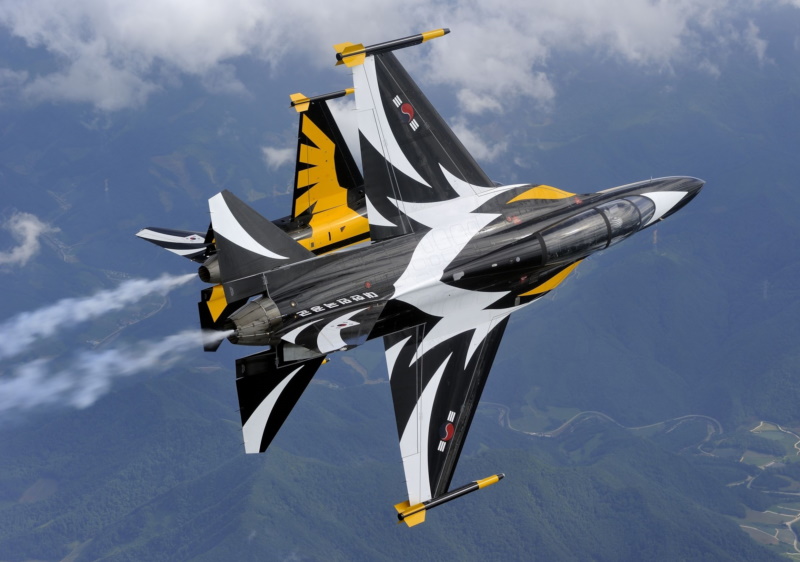
* As it emerged, the Golden Eagle was not only smaller than the F-16, it clearly differed in appearance in that it had an engine intake under each wing root, not a single intake under the belly, giving it an appearance somewhere in between the F-16 and the Taiwanese Ching Kuo fighter. The arrangement did otherwise closely reflect the F-16, with the same general flight surface and landing gear configurations. One noticeable change was that the wings featured leading-edge wingroot extensions over the engine intakes.
___________________________________________________________________
KAI T-50 GOLDEN EAGLE:
___________________________________________________________________
wingspan:
9.17 meters (30 feet 1 inch)
length:
13.13 meters (43 feet 1 inch)
height:
4.90 meters (16 feet 1 inch)
empty weight:
6,440 kilograms (14,200 pounds)
loaded weight:
11,975 kilograms (26,400 pounds)
max speed at altitude:
Mach 1.4
service ceiling:
14,630 meters (48,000 feet)
___________________________________________________________________
The Golden Eagle was powered by a General Electric F404-GE-402 afterburning bypass jet engine, of the same family of engine as used on the twin-engine F/A-18 Hornet, with FADEC and 78.8 kN (8,030 kgp / 17,700 lbf) of thrust. Incidentally, the baseline T-50 later became the "T-50A" -- a aerobatic "T-50B" variant having been provided to the Black Eagles, the ROKAF aerial display team, these machines being fitted with smoke generators.
Two variants were initially defined, including the standard T-50 trainer and the "TA-50 (originally A/T-50) Lead In Fighter Trainer (LIFT)", fitted to a combat standard for weapons training. The TA-50 LIFT had AN/APG-67(V)4 radar and an internally-mounted lightweight 20-millimeter three-barreled GE Vulcan Gatling cannon. The aircraft had a centerline stores pylon and two stores pylons under each wing for drop tanks, Mark 82 / 83 "slick" bombs, or AGM-65 Maverick missiles, and the ability to carry Sidewinder AAMs on the wingtips.
The TA-50 led to a pure combat version, the "FA-50" (originally "A-50"), which had an IAI Elta EL/M M-2032 multimode radar, a tactical datalink, defensive countermeasures, a total warload of 4,500 kilograms (9,920 pounds), and an extended range of weapons carriage capabilities. An AESA radar is a future. There's also been talk of an "F-50" single-seater, but no funding for development.
* The development program involved the production of two static-test aircraft, two T-50 flight-test prototypes, and two TA-50 LIFT flight-test prototypes. The first T-50 flight-test prototype was rolled out in the fall of 2001, with initial flight on 20 August 2002, and the second prototype followed it into the air on 8 November 2002. The first TA-50 LIFT prototype performed its initial flight on 29 August 2003. The first production batch, was ordered in December 2004, with the first production aircraft to rolled out in August 2005. Two aircraft were delivered to the ROKAF in December 2005 and introduction to service was in 2007.
The ROKAF has obtained over a hundred Golden Eagles, half of them T-50s and the other half TA-50 LIFTs. A number of FA-50s have been obtained as well. It's hard to track quantities, because deliveries are ongoing. The ROKAF could acquire up to a total of 150 to replace existing Northrop F-5 Tiger II fighters.
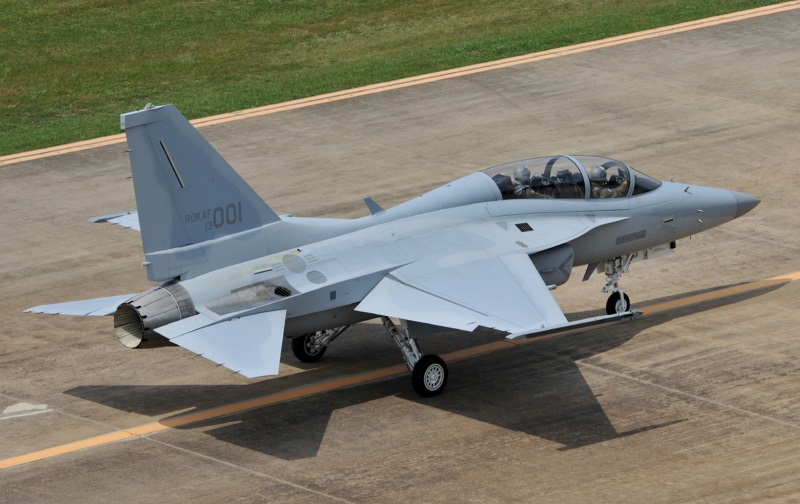
There have been other sales:
Argentina announced an FA-50 order in 2019, but the British government shot the deal down, because the FA-50 featured significant British content. KAI and Lockheed Martin also pursued the US Air Force's "T-X" jet trainer requirement, rolling out a "T-X demonstrator", later "T-50A", machine in late 2015, leading to initial flight on 2 June 2016; it was followed by a second aircraft in late July. The T-50As featured the basic T-50 airframe, but added in-flight refueling capability, a large-area cockpit display system, a roomier cockpit, and embedded training systems. A Boeing-SAAB team won the competition in 2018, and that was the end of the T-50A.
BACK_TO_TOP* For lack of a better place to mention this, the Vermont ANG "Green Mountain Boys" squadron built a little three-wheel scooter in the shape of an F-16. It even has dummy Sidewinders on the wingtips. It looks like good fun to play around in.
Some readers have objected to the use of the term "bypass jet" in this document to describe fighter engines like the F100, which are more conventionally called "turbofans". I see that as misleading; the "high bypass ratio" turbofans on a jetliner get most of their thrust from the fan, the purpose of the turbojet "core" of the engine being to turn the fan. The bypass ratio of fan to core is on the order of 5, with the latest engines headed up for 10. They're really much more like a turboprop than a turbojet, with the experimental "propfan" AKA "unducted fan" engines being a halfway step between the two.
An engine like the F100 does have a fan stage, but it contributes little to thrust, the bypass ratio being well less than unity; essentially, the F100 is a turbojet with a fan-driven cooling system. Early turbofans were sometimes referred to as "bypass turbojets", which seems more apt, but using that terminology got me complaints from readers. "Bypass jet" covers the bases, and nobody is misled by it. Somebody needs to come up with a better name.
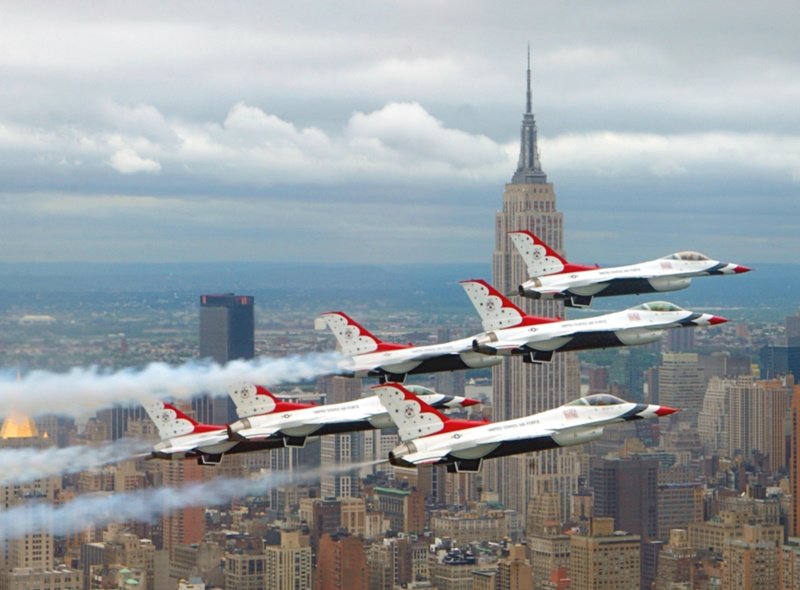
* Sources include:
The F16.NET website also has been an excellent source for data on the F-16
* Illustrations details:
* Revision history:
v1.0.0 / 01 apr 03 v1.0.1 / 01 apr 05 / General cleanup and update. v1.0.2 / 01 apr 07 / Review & polish. v1.0.3 / 01 may 09 / Review & polish. v1.0.4 / 01 may 10 / Review & polish. v1.0.5 / 01 apr 12 / Review & polish. v1.0.6 / 01 mar 14 / Review, update, & polish. v1.1.0 / 01 feb 16 / Review, update, & polish. v1.2.0 / 01 jan 18 / General cleanup. v1.3.0 / 01 jan 20 / More cleanup. v1.4.0 / 01 dec 21 / Review, update, & polish. v1.5.0 / 01 jan 24 / Review, update, & polish. (+)BACK_TO_TOP
